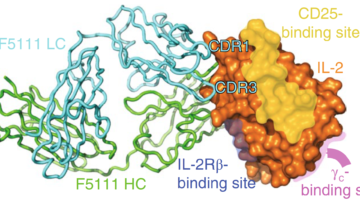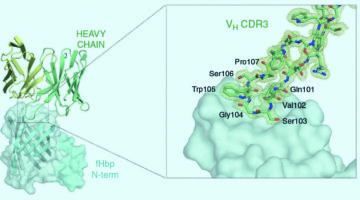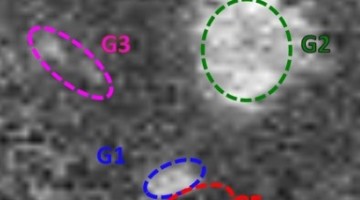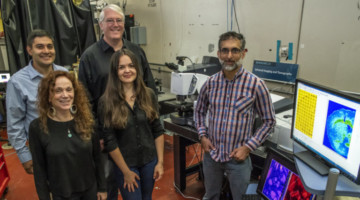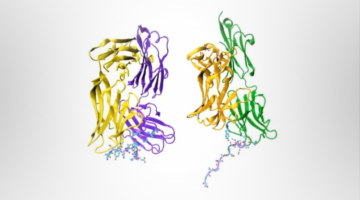The balance between two types of white blood cells is disrupted in autoimmune diseases. Using protein crystallography, scientists have identified a human antibody that locks interleukin-2, a signaling protein, in a conformation that preferentially activates one cell type to restore the balance and treat autoimmune diseases. Read more »
Targeting Bacteria That Cause Meningitis and Sepsis
Researchers determined the structure of a human antibody that broadly protects against a bacterium that causes meningitis and sepsis. The work provides molecular-level information about how the antibody confers broad immunity against a variable target and suggests strategies for further improvement of available vaccines. Read more »![]()
![]()
Near-field infrared nanospectroscopy and super-resolution fluorescence microscopy enable complementary nanoscale analyses of lymphocyte nuclei
Recent super-resolution fluorescence microscopy studies have revealed significantly altered nuclear organization between normal lymphocyte nuclei and those of classical Hodgkin’s lymphoma. Reported here are the first near-field IR imaging of lymphocyte nuclei, and far-field IR imaging results of whole lymphocytes and nuclei from normal human blood. Read more »
Unwinding a Quadruple Helix
The double helix is not the only structure formed by DNA and RNA. Guanine-rich DNA and RNA sequences can fold into quadruple-helix structures called G-quadruplexes. Recently, researchers visualized the unfolding of a G-quadruplex by a protein called DHX36, gaining valuable insight into a potential target for drug development. Read more »
Nanoscale Characterization of Iron and Calcium in the Alzheimer’s Brain
The amyloid plaques that accumulate in Alzheimer’s disease contain stores of iron. Using scanning transmission x-ray microscopy, researchers have characterized the iron’s chemical states in unprecedented detail. Their nanoscale analysis revealed excessive chemical reduction of the iron, which can release damaging free radicals. Read more »
Structure Reveals Mechanism Behind Periodic Paralysis
X-ray crystallography of a membrane protein provided a structural understanding of how a single mutation can result in periodic muscle paralysis. The results suggest possible drug designs that could provide relief to patients with a genetic disorder that causes them to be overcome suddenly with profound muscle weakness. Read more »![]()
![]()
Infrared Beams Show Cell Types in a Different Light
By shining highly focused infrared light on living cells, scientists hope to unmask individual cell identities and to diagnose whether the cells are diseased or healthy. Their focus is on developing a rapid, noninvasive way to easily identify cell types and features within living cells, to aid in biological and medical research. Read more »
Open and Shut: Pain Signals in Nerve Cells
Researchers used x-ray data to define the structure of a closed protein gate important for neuronal signaling. Comparing the closed gate with previously known structures of the same gate when open, researchers now have a comprehensive picture of proton-dependent channels in neurons. Read more »
Structures Reveal New Target for Malaria Vaccine
Researchers isolated human-derived antibodies that protect against malaria, and protein-structure studies revealed the antibodies’ site of attack. The discovery paves the way for the development of a more effective and practical human vaccine for malaria, which is responsible for half a million deaths every year. Read more »![]()
![]()
Meet Leda: Mother of Light
In Greek mythology, Leda is a Spartan queen and mother of the twins Castor and Pollux. In reference to the myth, Leda is also the name of the ALS’s recently delivered insertion device—an in-vacuum undulator. For the next eight months, Leda is taking up residence in the Building 15 high bay, awaiting installation during the January 2019 shutdown. Read more »
- « Previous Page
- 1
- …
- 14
- 15
- 16
- 17
- 18
- …
- 24
- Next Page »
